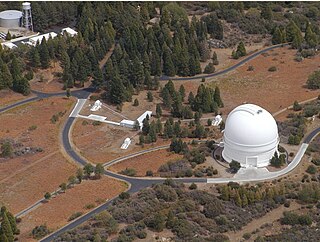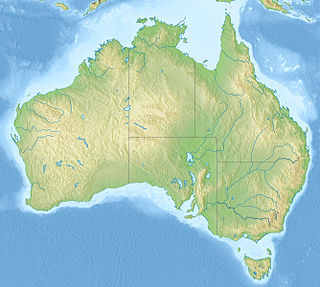The Fizeau–Foucault apparatus is either of two types of instrument historically used to measure the speed of light. The conflation of the two instrument types arises in part because Hippolyte Fizeau and Léon Foucault had originally been friends and collaborators. They worked together on such projects as using the Daguerreotype process to take images of the Sun between 1843 and 1845 and characterizing absorption bands in the infrared spectrum of sunlight in 1847.

Interferometry is a family of techniques in which waves, usually electromagnetic waves, are superimposed, causing the phenomenon of interference, which is used to extract information. Interferometry is an important investigative technique in the fields of astronomy, fiber optics, engineering metrology, optical metrology, oceanography, seismology, spectroscopy, quantum mechanics, nuclear and particle physics, plasma physics, remote sensing, biomolecular interactions, surface profiling, microfluidics, mechanical stress/strain measurement, velocimetry, and optometry.

The Mount Wilson Observatory (MWO) is an astronomical observatory in Los Angeles County, California, United States. The MWO is located on Mount Wilson, a 1,740-metre (5,710-foot) peak in the San Gabriel Mountains near Pasadena, northeast of Los Angeles.
The timeline of luminiferous aether or ether as a medium for propagating electromagnetic radiation begins in the 18th century. The aether was assumed to exist for much of the 19th century—until the Michelson–Morley experiment returned its famous null result. Further experiments were in general agreement with Michelson and Morley's result. By the 1920s, most scientists rejected the aether's existence.
Robert Hanbury Brown, AC FRS was a British astronomer and physicist born in Aruvankadu, India. He made notable contributions to the development of radar and later conducted pioneering work in the field of radio astronomy.

The Palomar Testbed Interferometer (PTI) was a near infrared, long-baseline stellar interferometer located at Palomar Observatory in north San Diego County, California, United States. It was built by Caltech and the Jet Propulsion Laboratory and was intended to serve as a testbed for developing interferometric techniques to be used at the Keck Interferometer. It began operations in 1995 and achieved routine operations in 1998, producing more than 50 refereed papers in a variety of scientific journals covering topics from high precision astrometry to stellar masses, stellar diameters and shapes. PTI concluded operations in 2008 and has since been dismantled.

The Narrabri Stellar Intensity Interferometer (NSII) was the first astronomical instrument to measure the diameters of a large number of stars at visible wavelengths. It was designed by Robert Hanbury Brown, who received the Hughes Medal in 1971 for this work. It was built by University of Sydney School of Physics and was located near the town of Narrabri in north-central New South Wales, Australia. Many of the components were constructed in the UK. The design was based on an earlier optical intensity interferometer built by Hanbury Brown and Richard Q. Twiss at Jodrell Bank in the UK. Whilst the original device had a maximum baseline of 10m, the NSII device consisted of a large circular track that allowed the detectors to be separated from 10 to 188m. The NSII operated from 1963 until 1974, and was used to measure the angular diameters of 32 stars.
Richard Quintin Twiss was a British astronomer. He is known for his work on the Hanbury-Brown and Twiss effect with Robert Hanbury Brown. It led to the development of the Hanbury Brown-Twiss intensity interferometer in the UK in 1954. Their work appeared to contradict the established beliefs about quantum interference, and he and Brown received the Eddington Medal of the Royal Astronomical Society for it in 1968.
An intensity interferometer is the name given to devices that use the Hanbury Brown and Twiss effect. In astronomy, the most common use of such an astronomical interferometer is to determine the apparent angular diameter of a radio source or star. If the distance to the object can then be determined by parallax or some other method, the physical diameter of the star can then be inferred. An example of an optical intensity interferometer is the Narrabri Stellar Intensity Interferometer. In quantum optics, some devices which take advantage of correlation and anti-correlation effects in beams of photons might be said to be intensity interferometers, although the term is usually reserved for observatories.

The Fizeau experiment was carried out by Hippolyte Fizeau in 1851 to measure the relative speeds of light in moving water. Fizeau used a special interferometer arrangement to measure the effect of movement of a medium upon the speed of light.
In optical astronomy, interferometry is used to combine signals from two or more telescopes to obtain measurements with higher resolution than could be obtained with either telescopes individually. This technique is the basis for astronomical interferometer arrays, which can make measurements of very small astronomical objects if the telescopes are spread out over a wide area. If a large number of telescopes are used a picture can be produced which has resolution similar to a single telescope with the diameter of the combined spread of telescopes. These include radio telescope arrays such as VLA, VLBI, SMA, LOFAR and SKA, and more recently astronomical optical interferometer arrays such as COAST, NPOI and IOTA, resulting in the highest resolution optical images ever achieved in astronomy. The VLT Interferometer is expected to produce its first images using aperture synthesis soon, followed by other interferometers such as the CHARA array and the Magdalena Ridge Observatory Interferometer which may consist of up to 10 optical telescopes. If outrigger telescopes are built at the Keck Interferometer, it will also become capable of interferometric imaging.

Gerard Theodore van Belle is an American astronomer. He received a bachelor's degree in physics from Whitman College in 1990, a master's in physics from The Johns Hopkins University in 1993, and a Ph.D. in physics from the University of Wyoming in 1996. While at Whitman College, he initiated as a member of the Sigma Chi fraternity.

The NASA Exoplanet Science Institute (NExScI) is part of the Infrared Processing and Analysis Center (IPAC) and is on the campus of the California Institute of Technology (Caltech) in Pasadena, CA. NExScI was formerly known as the Michelson Science Center and before that as the Interferometry Science Center. It was renamed NExScI in the Fall of 2008 to reflect NASA's growing interest in the search for planets outside of our solar system, also known as exoplanets. The executive director of NExScI is Charles A. Beichman.















